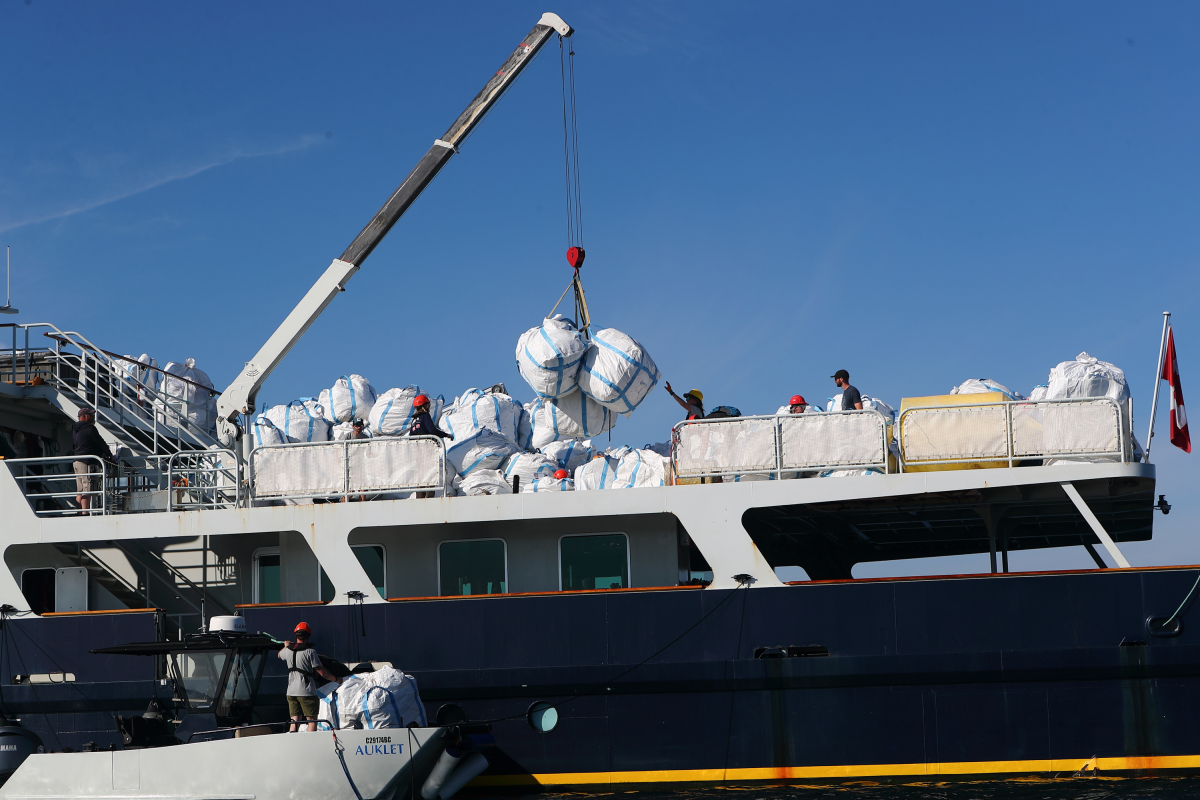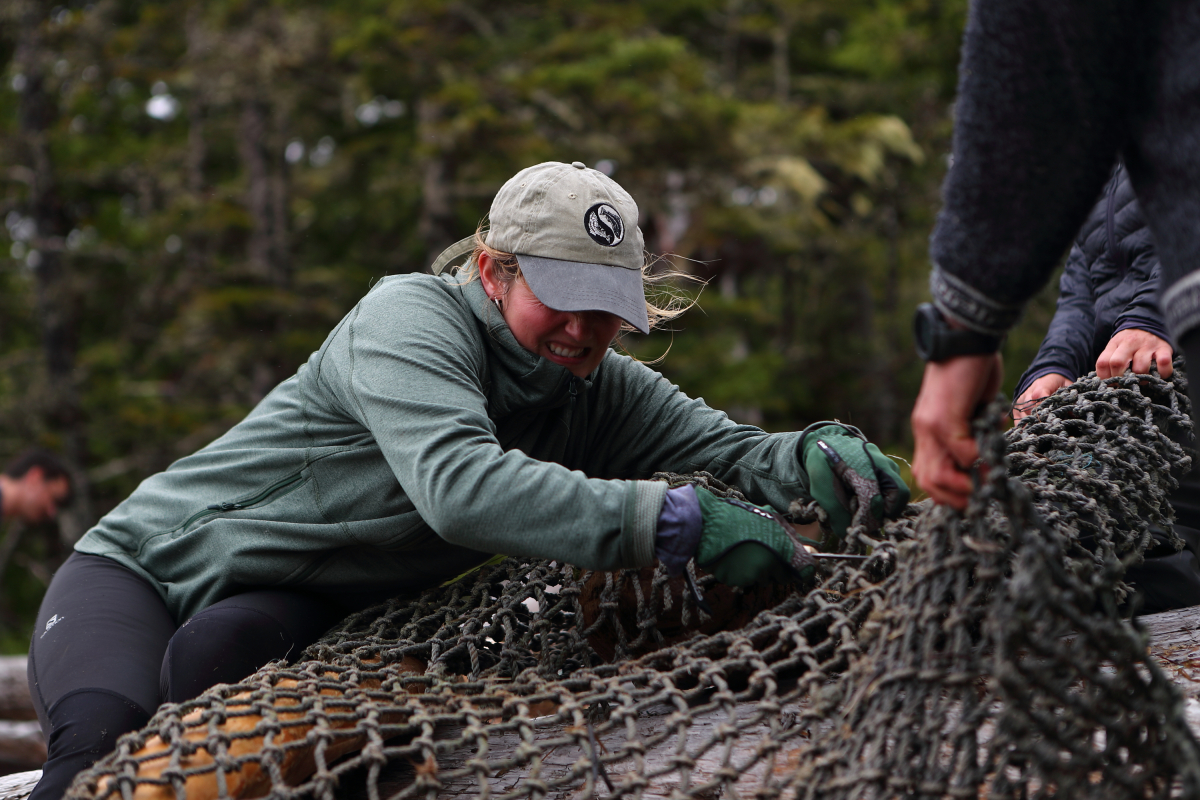Thank you for helping us meet our fundraising goal!
Canada's National Observer sent reporter Natasha Bulowski to B.C.'s remote central coast for a special expedition this month. This is her first dispatch.
Teams of people are on B.C.’s central coast this week, facing the Sisyphean task of removing marine debris and garbage from remote islands. For every plastic bottle you pick up, there are at least five more buried under the mess of driftwood washed up on the shores. Ropes and nets are even worse: right when you think you’ve freed a section and are ready to move on, a flash of turquoise rope buried in the driftwood catches your eye and condemns you to another 15-minute to hour-long struggle — or “project” as the crew calls these monstrosities.
The 12-person crew aboard Bluewater Adventures’ Island Roamer is one of three teams involved in this year’s marine debris removal operation, and Canada’s National Observer is along for the slog.
Crew member Evan Sztricsko described it as “integrated shoreline crossfit.”
When you’re pulling huge ropes or massive dock floats out these things can weigh "a lot, a lot, a lot," Sztricsko said.
“It can take two, three, four, people to get some of these pieces of debris out of where they've been jammed or where they're resting, to get them down onto the boats, to get them onto the larger boat for disposal,” he said.
For many crew members, this is not their first rodeo. The cleanup crews are mainly composed of coastal guides, who have a strong knowledge of the shoreline ecosystems and the skills to access remote beaches and coves.
The Wilderness Tourism Association of BC and Small Ship Tour Operators Association of BC did their first cleanup expedition in 2020, followed by another round in 2021. For that second cleanup, the team was armed with $3.5 million for a barge, tug and helicopter and the project was triple the size of this year’s expedition. More than 100 crew from nine boats and neighbouring communities successfully removed 210 tons of debris from 306 km of shoreline that year, but ran out of time and funding due to the high volume of debris on Banks Island and Aristazabal Island.
Now they are back, with a small fraction of the funding, to continue cleaning up the coast and see how much new debris has washed up since they last scoured the area three years ago. The province contributed $3.5 million each for the first two expeditions. This year, the budget is just under $750,000.

Island Roamer is one of two boats responsible for visiting the beaches, collecting debris, bagging it and storing it in caches above the high tide line for the 140-foot Cascadia to pick up. Cascadia can carry up to 30 tonnes of debris and sports a five-tonne crane to help winch bagged debris out of small boats alongside it.
The plan is to fill Cascadia with as much debris as it can handle – about 30 tonnes — by the end of the trip. At the time of writing, Cascadia has approximately 20.82 tonnes on board and another three tonnes of bags left to pick up along shore. And, there are still plenty of islands full of trash left to clean before the Island Roamer returns to port in Kitimat on Aug. 10.
A tonne of trash can take many forms: depending on the material, picture a dense clump of rope about the size of a large couch, all the way up to a looser mass the size of a van. It’s half buried in sand, tangled together, broken apart, decaying and messy.
Island Roamer left Prince Rupert on July 27 and headed south to Aristazabal Island. The first three collection days were dark, rainy, cold and wildly successful. The crew cleaned up 1.3 tonnes of debris on the first day alone, after an hour wrestling with a roughly 700 kilogram mess of fishing nets and ropes in a cove in the north end of Clifford Bay. The following day they recovered more than a tonne, and the third day was a massive effort for nearly two tonnes of debris.
The crew sorts debris into garbage and recycling, the latter of which gets sent to the Ocean Legacy marine recycling facility in Richmond, B.C..
Large debris, such as plastic fishing gear, nets and rope and polystyrene floats, are the most visible symptom of plastic pollution, but only represent the tip of the iceberg. These macroplastics break down into smaller and smaller pieces, leaving the world’s oceans filled with microplastics that are changing the chemistry of the water. Those microplastics are now showing up in our bloodstreams, food and the air we breathe.
It feels good to get large plastic fishing gear and single-use bottles out of the ocean ecosystem before it can break down into microplastics, said Ryan Masson, captain of the Island Roamer.
On a typical day, the crew eats breakfast at 7, splits into two teams and scours nearby bays and coves for debris. Everything from the countless water bottles to giant bulbous fishing floats is then sorted into garbage and recycling and transferred to lift bags for the Cascadia to collect.
A lot of debris washing up on the shores is standard fare: fishing gear, plastic bottles and the like.
But there’s also a steady stream of debris from a massive cargo ship accident in 2021, when the ZIM Kingston lost 109 shipping containers overboard; last week, the Transportation Safety Board released its report on the accident, finding that Canada lacks preparedness for marine emergencies. The crew is constantly finding evidence of the accident washed ashore. Some of the more eye-catching items include children’s bike helmets (many of which have mohawks), inflatable toy unicorns, dinosaur vacuum hoses and colourful patterned children’s play mats.
Reusing is always preferable to recycling, so sometimes debris gets a new lease on life aboard the Island Roamer. Good-quality floats and rope are used for practical purposes and some relics like the inflatable unicorn are adopted for their morale-boosting properties.
But some of the trash is just that: trash.
When a heavy mooring rope is finally unsnarled from the rocks and driftwood after 30 minutes of cutting at the rope and moving heavy logs the beach will erupt with triumphant cries. Victories like this give everyone the strength to lug 100-plus kilogram bags of rope and debris along the beach to a pickup point.

Sztricsko participated in the 2021 marine debris removal initiative, and cleaned many of the exact same beaches the Island Roamer visited this time round.
“Coming back out into these places and seeing it three years later, you do realize that what we did three years ago actually did make a bit of a difference,” he said.
“There's tons out here, but there's less out here than there was three years ago on the beaches that we know that we hit.”
Still, it keeps piling up. The amount of debris that has washed up on these shorelines in the last three years is “shocking,” said Kevin Smith, CEO of Maple Leaf Adventures, the company that owns the Cascadia and another, smaller collection boat called the Maple Leaf.
At the time of writing, Cascadia had six tonnes of rope on board, four tonnes of garbage and an estimated 12,000 plastic bottles. There’s still more shoreline to scour, but they’ve already run out of lift bags, which makes it much harder to transport and store the debris.
Jeff Reynolds, debris data specialist aboard Cascadia, was also surprised by the volume collected on this smaller expedition.
“Going into it I didn’t think we’d be collecting this much so efficiently,” Reynolds said. “But here we are with a boat full of garbage and beaches that are still full.”
Nataasha Bulowski / Local Journalism Initiative / Canada’s National Observer




Comments